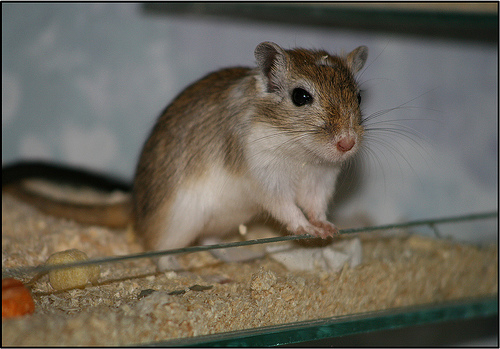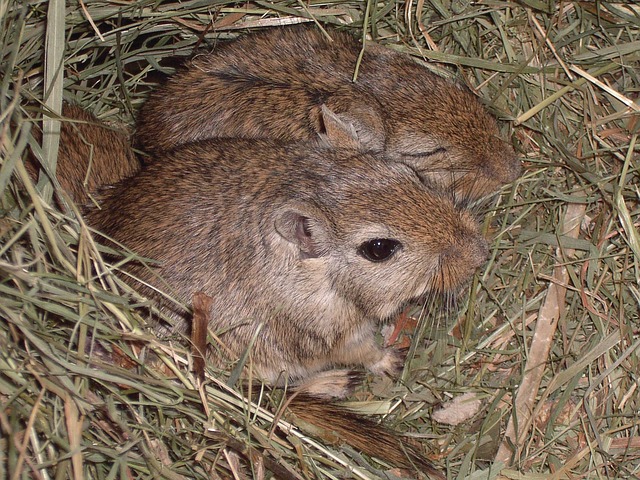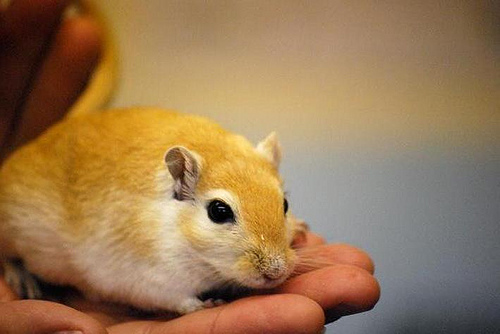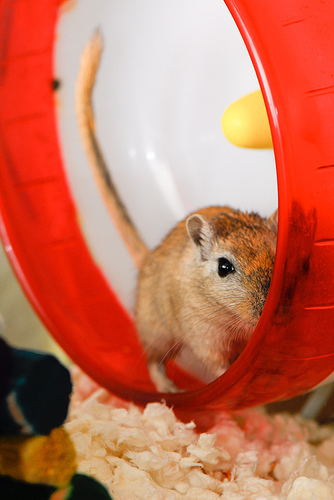Golden Agouti: A* C* D* E* P* Uw*
Agouti is the name of the ‘wild’ coat color of the Mongolian gerbil and the word agouti describes their speckled brown coat ticked with little black tips, white tummy and black whiskers.

Many wild rodents have this ‘agouti style’ of coat varying in colour to suit their environment including all jirds, degus, rats, mice, voles and squirrels, etc, as well as most species of rabbit and hare (lagomorphs). It makes sense to be camouflaged out there to outwit predators…
Agouti is also the name of the main gene that creates this ‘ticked’ appearance (given the genetic upper-case symbol [A] in gerbils) and is due to each single hair being created with 3 different colored sections.
This amazing piece of evolution creates their grizzled appearance (see image below); and in gerbils, the main base of the hair closest to the body is grey, the middle section is gingery-brown and the tips are black. As they move their body whilst feeding or grooming, the hairs bend with them, altering their appearance to blend into the habitat they live in.

This gene also gives the gerbils a totally white stomach, this is presumed to be an evolutionary trait so that their lower half which is in contact with the hot desert sand reflects away the intense heat. There are other theories about this – and we shall certainly read more about it in good time.
This Agouti gene also helps us split all the existing gerbil colors into 2 main groups; those with the agouti (ticked hair) gene [AA or Aa] which are often called ‘the agouti-based colors’; and those without the agouti (ticked hair) gene [aa] are called either the ‘non-agouti colors’, ‘self colors’ or maybe even the ‘black colors’.
These two groups form color partners of each other – so each colour on the Agouti side has a matching color on the non-Agouti side – with only the [A] gene version being different. This is a great tool for helping with colour ID and selective breeding.
So far, all known Mongolian gerbil colours fit into one of these two groups of colors.
I’m not sure it IS Agouti yet?
 If you aren’t sure if your gerbil is Agouti compared to the image above – the only other colors it could be are either a Dark-Eyed Honey (DEH) or a Nutmeg.
If you aren’t sure if your gerbil is Agouti compared to the image above – the only other colors it could be are either a Dark-Eyed Honey (DEH) or a Nutmeg.
Dark-Eyed Honey – lighter coat overall, as well as having a lot more white on the tummy.
The demarcation line (where the body colour meets the white tummy) for the ee gene is higher than on the Agouti and so you can always see it clearly on a moving gerbil – and the white even extends up around the eyes and behind the ears.
Basically you would describe a DEH as a ginger and white gerbils, whereas you would most likely describe an Agouti gerbil as brown – with a white tummy…

Nutmeg – lighter patterned Nutmegs could look like an Agouti at first, but then looking closer you can see that the ‘ticking’ is in patches not uniform all over.
You can also split the coat to the roots and the individual hairs will be the same color all the way to the root in a Nutmeg including the ginger hairs – however, if you split the hairs on an Agouti and they are all dark underneath.
Also, a Nutmeg doesn’t have a white tummy.
It might have a tummy that is paler than its back – but it won’t be white.
If the Nutmeg is spotted it will have a small amount of white on its tummy, but not to the same extent as an Agouti.
You have Agoutis you want to Breed?
Due to the prevalence of all the dominant genes needed to create an agouti-colored gerbil, this colour is one of the most commonly seen gerbil colours in litters of pups.
It is much easier to get an Agouti pup from random genes than it is to get a Polar Fox for example. Sometimes you can breed together two delightfully unusual colors – and get 100% Agouti pups in the litter.
Genetics-wise, the genes for an Agouti gerbil are so ‘strong’ (strong in this instance means prevalent and dominant), that if you mate an Agouti gerbil to almost any other color gerbil, you will always get Agouti pups in the mix.
You want Agouti Pups?
Perfect – you are in luck. There are loads of different ways to get Agouti pups in your litters depending on the colors you already have and the genes you already know about.
If you want 100% Agouti pups you would need to have an Agouti adult with all the dominant genes in both pairs [AA CC DD EE PP UwUw] then, no matter what other gerbil you bred them to, you would ALWAYS get Agouti pups – and only Agouti pups.
Breeding an Agouti gerbil with unknown genes will always create more Agoutis, but to varying degrees.
Without knowing their genes the best way to increase the number of Agouti pups in your litters is to avoid breeding to any gerbils with red/ruby/pink eyes for starters, and try to also avoid any gerbils with more than one set of recessives – so Silver Nutmegs/Polar Foxes (which both have ee + uwᵈuwᵈ) and [L]CP Slates/[L]CP Grey Agoutis (which both have c*c* + uwᵈuwᵈ).
These combinations don’t stop you getting Agoutis, they just lower the amount of Agoutis you will get by adding loads of alternate colors. It’s like adding more socks to a laundry pile – you just end up with more pairs.
Don’t have Agoutis – but want them?
If you don’t have an Agoutis of your own but still want them – you could try one of the 2 following plans to get them…
1) Breed any agouti-based gerbil with a Black gerbil
2) Breed any shade of Argente gerbil with any dark-eyed gerbil
For sure though – avoid breeding two gerbils together who have a trait that Agouti gerbils don’t have – for example – don’t breed together two gerbils with pink-eyes or two gerbils that are colorpoint. Agoutis don’t have pink eyes and aren’t colorpoint – so you won’t ever get them in your litters.
Don’t want Agouti pups in your litters?
The only ways you can be sure of NOT getting Agouti pups in your litter are:
Using a pair of gerbils which both carry the SAME recessive genes.
This would mean something like breeding 2 ee gerbils together (like a Yellow Fox/REH and a DEH; or a Nutmeg and a Polar Fox). If both parents do not carry the dominant E version of this gene – you can’t ever get Agouti pups from that pairing. Same goes for breeding 2 pink-eyed gerbils together.
Only breeding non-agouti-based colors.
Now this technically falls into the same category as above as all non-agouti-based gerbils HAVE TO HAVE the same 2 recessive genes of [aa] and so you will never get Agoutis – and then you can breed any of these aa gerbils together – they don’t have to have the same recessive gene but it doesn’t matter if they do, so Black to Nutmeg or Silver Nutmeg to Burmese, etc.
Using either of these techniques above also limits the number of other colors you will get overall too, but once you start breeding and seeing the pups, you can write down your expressed genes and work out who is best for what further down your line.
For more information about Breeding for Color please do read on…
Is there a correlation between coat colour and behavior? I know this to be true with mice and rats and often has to do with them being outbred or inbred strains. I also recognize that due to the dominance of the agouti gene, it may be hard to tell if there are recessive genes present that may affect behavior, but if you know if a black or other self gerbils are likely to have different behavioral characteristics then agouti, then it might help point me in the right direction. I’m looking for a more docile and curious strain.
What a great question – and in our own experience there isn’t really any link between colour and character – it seems just luck of the draw.
In any pairing (a clan) there will always be one that is more outgoing and they are usually the more dominant one. When they are only mildly dominant then both gerbils can be fun a lively – however, if the dominant one is very overpowering, then the second gerbil will always act reserved and quiet – often not coming out to humans for interaction if the other one tell them to ‘go hide’. So depending on this set up – ANY colour can be the quiet one – and you won’t see their true character until they aren’t living with the other one – so it can quite complicated.
There are sometimes stories with individuals being much more human-loving than normal – but of course they are outside of their normal clan rules so are free to act as they wish.
Some people also say that those with red eyes (thought to reduce/affect sight) can be a bit more skittish because – depending on the set up and location of the enclosure – they may be more reactive to shadows (and therefore humans) and so avoid being approached as they are confused by all the moving shapes – a predator safety reaction (gerbil threats are normally thought to be from the sky).
It might be worth doing a survey with gerbil owners to see if – in a pair – there is more likely to be a certain colour that is more dominant – and perhaps Agouti would make sense? This could open up a whole new area of study for us gerbil keepers…